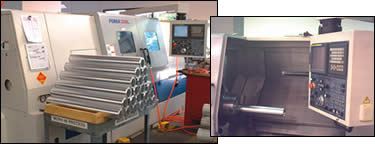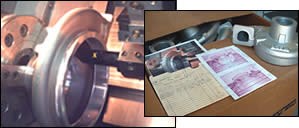Turning The Long And Difficult
This shop has made large turning work its specialty. In proving to its customers that it can perform this difficult work, it has started to win more "standard" machining jobs.
Share





You obviously have a competitive advantage when you can machine parts that others can’t. The tough work that you’ve chosen to make your specialty can have a gravitational pull on more “traditional” machining work from your customers. That’s been the experience for R&D Manufacturing Industries, Inc., located in Ocala, Florida. The “R” and “D” are Ron Malone, company president, and his partner, Dennis Miller.
The two men identified a need for large CNC turning capability in their portion of the Sunshine State. They decided to combine their lean manufacturing and metalworking experience to make such turning work their niche. Considering the variables related to the machine, tooling and workholding that make turning large parts a challenge, this decision was a bit of a gamble. In their case, the stakes were high, because the decision to go “all in” was based simply on the chance to win one tough turning job—32-inch-long, 4-inch-diameter air purification cylinders with tricky DIN 405 rounded-type internal threads on both ends.
The gamble has paid off, as that job has led to additional difficult turning work. That difficult turning work has resulted in R&D winning all of one customer’s machining work. The key for Mr. Malone and Mr. Miller is not to go after jobs at half-throttle. After identifying jobs that appear to be a good fit for the shop, they take the time to make sure all their processing ducks are in a row. This means that when the volume comes in, they can hit the ground running.
Long Turn
The opportunity to win the air purification cylinder work drove Mr. Malone and Mr. Miller to purchase what they believe to be one of the biggest CNC lathes in the Southeast—a Puma 300L from Daewoo Machine Tool Division (the West Caldwell, New Jersey division of Doosan Infracore). The machine, a barely used unit purchased through Arthur Machinery (Elk Grove Village, Illinois), has a maximum turning length of 52 inches and provides 18 inches of swing. Mr. Malone notes that while there are area shops primarily serving the oil and paper industries that have large manuals, a CNC lathe with a through hole that can accept 4-inch-diameter barstock is rare in his neck of the woods.
Having a lathe with sufficient through-hole capacity to accept the cylinders was only one piece of the puzzle, however. The cylinders required both ID and OD turning along their entire length. Turning the OD would not be very challenging. Because the distance between the turret and cutter is short, the tool is well-supported during the cut. The trick would be boring the 32-inch-long cylinders, which would require a tool that would work at a high L/D ratio. This is difficult because the vibration between the cutting tool and workpiece—known as chatter—is prone to occur with long tool overhang.
The men determined that they needed a boring bar that was at least 24 inches long in order for it to reach more than halfway into the tube. After boring that section of the tube, it would then be removed, reversed and re-chucked to complete the boring of its other half. The men settled on a Silent Tools boring bar from Sandvik Coromant (Fair Lawn, New Jersey). The tuned boring bar controls chatter by means of a passive damper within the bar. This damper consists of a heavy tuning body suspended in the bar by two rubber bushes. A viscous liquid fills the gap between the tuning body and the inside surface of the bar. If vibration occurs during the machining process, then the tuning system will come into play and the kinetic energy of the bar will be absorbed into the tuning body. As a result, vibration is minimized, and precise dimensional tolerances and surface finish can be attained. In the case of the cylinders, controlling chatter is especially important to ensure that there is a clean overlap of the two boring approach directions.
There was initial concern that the bar’s weight might affect the lathe turret’s ability to accurately position the bar as it indexes into position (it was thought that the turret might over-index slightly). However, the company has yet to experience a problem maintaining straightness of 0.001 inch over the entire length of the bar. A single cutting edge is used because surface finish is more important than high material removal rate. Each end of the tube is turned in two passes.
The large lathe is also used to turn threaded caps for the cylinder ends from 4-inch-diameter aluminum barstock. In an effort to enable lights-out machining, the shop is adding a bar puller from Royal Products (Hauppauge, New York) to the lathe. Bar pullers tend to be less costly than bar feeders; take up less floor space because they install in a turret station; and require no electrical interface with the lathe’s control. The men are currently designing a chute-type parts handling system to gently collect the machined caps in such a way that they don’t collide together, which could mar their threads.
Another Tricky Turn
Scroll-shaped volutes for fire truck pumping systems constituted another difficult job for R&D that, again, required large turning capacity and special tooling. The aluminum castings have a mounting arm that sticks out, creating a natural out-of-balance condition while rotating in the chuck. In addition to the eccentric rotational effect, a groove tool must reach into the large opening to generate a groove while the tool and the turret avoid contact with the arm.
The men knew that they could swing the part by chucking the part and spinning it by hand to ensure there were no interferences. Also, they were confident that the machine and its spindle would have the rigidity to spin such an odd geometry. Again, they worked with Sandvik to find tooling that would create the internal NPT threading in the volute’s small diameter side and the intricate groove on the other side of the part inside its large opening. Each groove wall has a 20-degree taper and 0.125-inch radius at the bottom. A 70-degree tool was chosen for the walls, and a 0.25-inch insert was used to produce the radii.
To secure the volutes, R&D created custom chuck jaws that could grip the workpiece by either side simply by changing the chucking direction. The jaws can both clamp down onto the small end’s OD and also expand within the large opening to secure the part from that side. The shop can perform external turning and grooving, as well as ID boring and NPT-style thread on the small side by chucking the large ID. It will machine the small side of one batch of parts, and then complete the turning work on the large opening for that batch of parts.
After those initially machined volutes passed burst and leakage tests, the customer gradually began feeding volute work to R&D until it finally gave all the volute work to the shop. By proving that it could do the tricky turning work on-time and on-spec, R&D became the customer’s sole supplier of all nine of the machined components used in the pumping system.
To Turn Or Not To Turn?
As far as determining whether they can or should take on a tough turning job, Mr. Malone and Mr. Miller don’t have a formal checklist they run through. Some of the questions they ask themselves include: Do we have a lathe with sufficient through-hole or swing? Will special tooling be required? Can the workpiece be completely machined in one setup, or will more than one setup be required? And finally, does it appear that the job will result in a steady stream of work? This last question is particularly important. The two heavily weigh whether it is worth devoting the time and effort to developing a machining strategy for a part that they may never see again.
Related Content
Toolpath Improves Chip Management for Swiss-Type Lathes
This simple change to a Swiss-type turning machine’s toolpath can dramatically improve its ability to manage chips.
Read MoreOrthopedic Event Discusses Manufacturing Strategies
At the seminar, representatives from multiple companies discussed strategies for making orthopedic devices accurately and efficiently.
Read MoreHow to Accelerate Robotic Deburring & Automated Material Removal
Pairing automation with air-driven motors that push cutting tool speeds up to 65,000 RPM with no duty cycle can dramatically improve throughput and improve finishing.
Read MoreCustom PCD Tools Extend Shop’s Tool Life Upward of Ten Times
Adopting PCD tooling has extended FT Precision’s tool life from days to months — and the test drill is still going strong.
Read MoreRead Next
Leveraging Little Holes To Lure Additional Work
Not many contract shops can drill a 0.001-inch hole. This one can, and it uses its micro-hole-making capabilities to attract more 'traditional' machining work from its customers.
Read More5 Rules of Thumb for Buying CNC Machine Tools
Use these tips to carefully plan your machine tool purchases and to avoid regretting your decision later.
Read MoreBuilding Out a Foundation for Student Machinists
Autodesk and Haas have teamed up to produce an introductory course for students that covers the basics of CAD, CAM and CNC while providing them with a portfolio part.
Read More


















.jpg;maxWidth=300;quality=90)













